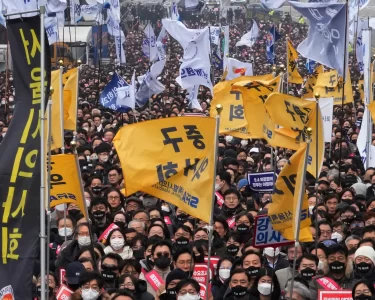The Maldives is a strategically important nation in the Indian Ocean, now facing a high risk of debt distress due to its increasing proximity to China. The IMF has warned the Maldives that it needs to make urgent policy changes to avoid falling into debt. The Maldivian economy, which is heavily reliant on tourism, suffered greatly during the Covid pandemic but has since started to recover. The island nation is taking steps to boost tourism, such as expanding its airport and increasing the number of hotels. However, the IMF has warned that there is still a lot of uncertainty surrounding the outlook for the Maldivian economy.
Under the leadership of former president Abdulla Yameen, the Maldives pursued extensive construction projects funded by loans from China. This reliance on Chinese financing left the country deeply indebted, with over 42% of its $3 billion foreign debt owed to China as of 2021, according to the World Bank. In simple terms, the Maldives ended up owing China a significant portion of its entire foreign debt. This raises concerns about the country’s financial stability and potential dependence on China. The current president, Mohamed Muizzu, is pro-China and has distanced the Maldives from India. This has led to some tension between the two countries. Muizzu has also vowed to strengthen the Maldivian military, which has raised concerns about a potential arms race in the region.
Earlier, in 2020, the Maldivian businessman Ahmed Siyam was forced to repay a $127.5 million loan from China’s EXIM Bank, leading to concerns about the island nation falling into a “debt trap.” The incident highlighted the risks associated with the Maldives’ heavy reliance on Chinese loans, shrouded in secrecy and backed by sovereign guarantees. Siyam’s company was unable to service the debt, prompting the Chinese bank to pressure both him and the Maldivian government for repayment. Transparency advocates had warned that the true extent of the Maldives’ debt to China might be much higher than officially reported. They emphasize the need for transparency and scrutiny of such loan agreements, especially considering the country’s fragile economic state due to the pandemic-induced tourism slump. Analysts warned of limited financial buffers and the dangers of relying heavily on loans, urging the Maldives to diversify its financial partners and seek concessional funding to manage its debt burden. The incident with Siyam’s loan served as a stark reminder of the potential pitfalls of opaque borrowing arrangements, prompting calls for greater transparency and responsible debt management.
The Maldives relies heavily on imported goods and thrives on tourism. While the economy is expected to grow in 2023 and 2024 with 1.8 million tourists anticipated, a global downturn could cause the tourism sector to shrink. Another concerning issue is the rising national debt, especially since government revenue significantly dropped compared to a smaller decline in spending. However, there is a focus on boosting the domestic economy through increased credit in key sectors like tourism, personal loans, and real estate. While interest rates on savings remain stable, borrowing has become more expensive for businesses. Additionally, trade contracted in September 2023, with exports falling sharply, driven by a decline in both re-exports and domestic goods.
China’s “String of Pearls” strategy aims to build strategic outposts in the Indian Ocean, and it sees the Maldives as a crucial link. However, this ambition clashes with the Maldives’ vulnerability to rising sea levels due to climate change. This creates a complex situation where economic benefits from closer ties with China (represented by the proposed Free Trade Agreement) must be weighed against potential environmental threats. Newly elected President Muizzu’s pro-China stance throws further uncertainty into the mix, threatening to strain previously strong India-Maldives relations. Policymakers on both sides are trying to navigate these choppy waters, considering the potential impact of China’s growing influence and the fate of the FTA.
The FTA, initiated in 2015, aimed to strengthen economic ties between the two nations. Though signed in 2017, its lopsided nature – favouring China due to the vast economic disparity – raised concerns. Supporters, however, believe it offers mutual benefits in trade, investment, and technical cooperation. Covering 96% of bilateral trade, the agreement seemed promising. However, it remained unratified due to changes in Maldivian leadership. President Solih’s “India First” policy put the deal on hold, leaving Chinese businesses unsure about future opportunities.
With President Muizzu keen on strengthening ties with China, the 2017 Free Trade Agreement (FTA) is likely to be implemented, potentially with some modifications. An FTA typically eliminates tariffs and restrictions on trade between member countries, while also setting regulations and fostering cooperation beyond trade, like technology and knowledge sharing. However, before rushing into the agreement, a thorough analysis of its clauses is crucial for understanding its impact on both nations and the wider South Asian region.
The revised tariff structure is a critical aspect. The FTA divides Chinese imports into three categories: immediate tariff elimination, gradual elimination over 5-8 years, and tariffs remaining at 2014 levels. Notably, any good originating in China, even if imported through a third party, falls under the FTA structure, meaning no tariffs.
This raises concerns. China already dominates Maldivian imports, generating significant government revenue through tariffs. Eliminating these tariffs would not only impact Maldivian income from China but also from countries re-exporting Chinese goods. This combined revenue loss could contribute to rising national debt, forcing the government to either increase internal borrowing or domestic taxes. Both options could severely impact household spending and even push the Maldivian economy towards contraction.
The government of former President Solih when it took office in 2018 was plagued by similar concerns. The Solih government discovered the shocking reality: their nation was saddled with $3.1 billion in debt to China. This figure, according to former Speaker of Parliament Mohamed Nasheed, included various forms of loans and guarantees. He feared the country had fallen into a “debt trap,” as the projects funded by these loans lacked clear plans for generating enough revenue to repay them. Nasheed alleged that the projects were inflated, leading to a debt figure far higher than the $1.1 billion received. However, both former Maldivian officials and Chinese representatives disputed it, claiming the true debt falls between $1.1 billion and $1.4 billion. Nasheed also worried about potential defaults like Sri Lanka, which struggled to repay its Chinese loans after borrowing heavily for post-war reconstruction. In conclusion, President Muizzu’s alignment with China has ensnared the Maldives in a perilous web of Chinese debt, stemming from past projects and potential policy choices. The Chinese “String of Pearls” strategy and potentially implementing the lopsided FTA, the nation risks prioritizing short-term gains over environmental sustainability and straining ties with India. Muizzu’s policies echo concerns of falling into a Chinese debt trap, contrasting with former President Solih’s cautious approach. The imperative now is for the Maldives to reassess its economic strategies, prioritize transparency, and diversify financial partners to secure long-term stability, highlighting the impact of leadership choices on national prosperity. (Singapore Post)






